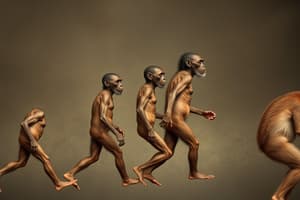Podcast
Questions and Answers
What is the estimated heritability percentage of schizophrenia in human populations?
What is the estimated heritability percentage of schizophrenia in human populations?
- 80% (correct)
- 30%
- 60%
- 95%
What is the primary genetic distinction between monozygotic and dizygotic twins?
What is the primary genetic distinction between monozygotic and dizygotic twins?
- Monozygotic twins share 50% of their genes.
- Dizygotic twins share 100% of their genes.
- Monozygotic twins share 100% of their genes. (correct)
- Dizygotic twins only share environmental factors.
What percentage of human DNA is made up of functional genes that code for proteins?
What percentage of human DNA is made up of functional genes that code for proteins?
- 2% (correct)
- 15%
- 10%
- 5%
What is the role of Neanderthal admixture in relation to schizophrenia as suggested by the text?
What is the role of Neanderthal admixture in relation to schizophrenia as suggested by the text?
Which process is NOT part of the natural selection steps discussed?
Which process is NOT part of the natural selection steps discussed?
What is the primary function of telomeres in chromosomes?
What is the primary function of telomeres in chromosomes?
What role do histones play in the structure of DNA?
What role do histones play in the structure of DNA?
How does the risk of developing major depression change for individuals with a family history of the condition?
How does the risk of developing major depression change for individuals with a family history of the condition?
In which cellular location does the process of translation occur?
In which cellular location does the process of translation occur?
What is the key difference between RNA and DNA during transcription?
What is the key difference between RNA and DNA during transcription?
Flashcards are hidden until you start studying
Study Notes
Modern Taxonomic Groups
- Homo sapiens are the only existing species of the genus Homo
- Y-chromosomal Adam is the most recent common ancestor of all living males
- Mitochondrial Eve is the most recent common ancestor of all living females
Schizophrenia
- Schizophrenia effects about 1% of the world population
- The heritability of schizophrenia is estimated to be as high as 80%
- The genetic component of schizophrenia risk emerged recently in hominid evolution
- People with a higher Neanderthal admixture have less severe positive symptoms
- Individuals with schizophrenia tend to have a lower NeanderScore
Human Genetic Variation
- All humans are 99.9% genetically identical
- The 0.1% variation accounts for all human differences
- The human genome contains 3 billion nucleotides
- Less than 2% of human DNA codes for proteins
- The human genome contains approximately 20,000 genes
Natural Selection
- Natural selection is based on variation, heritability, struggle for existence, and survival and reproductive rates
Twin Studies
- Twin Studies are used to examine the influence of genes and the environment
- Monozygotic twins share 100% of their DNA and the same environment
- Dizygotic twins share 50% of their DNA and the same environment during gestation, birth, and development
Major Depression
- Studies have estimated that the heritability of major depression is between 40% and 50%
- The heritability of severe depression is probably higher
- If a family member has major depression, an individual has a 2-3 times greater risk of developing depression
Human Karyotype
- Humans have 46 chromosomes
- There are 22 pairs of chromosomes from each parent
- One set of sex chromosomes determines gender:
- Females have XX chromosomes
- Males have an XY chromosome
Structure of DNA
- The genome is the complete set of genetic information of an organism
- Chromosomes are long strands of DNA wrapped around proteins called histones
- Telomeres are located at the end of each chromosome and protect the DNA during cell division
- Genes are sections of DNA that code for proteins
- Alleles are alternative forms of a gene found at the same locus on a chromosome
Genotype and Phenotype
- Genotype refers to the genetic makeup of an organism
- Phenotype refers to the observable characteristics of an organism, which are influenced by both genes and the environment
- Phenotypes can include features like sensitivity to food reward, likelihood of depression, tendency to persist, and risk of developing diabetes
DNA Processes
- Transcription occurs in the nucleus and involves copying DNA into mRNA
- Translation occurs in the cytoplasm and involves converting mRNA into a protein at the ribosome
- The genetic code is a set of three nucleotides called a codon, which specifies which amino acid will be placed in a protein during translation
Transcription and Splicing
- Transcription involves copying a gene from the DNA template into a primary RNA molecule
- RNA differs from DNA in that it has uracil (U) instead of thymine (T), is shorter in length, and can leave the cell nucleus
- During splicing, introns are removed from the RNA molecule and remain in the nucleus, while exons are exported from the nucleus
Studying That Suits You
Use AI to generate personalized quizzes and flashcards to suit your learning preferences.





